Finding the perfect haircut for your little boy’s curly hair can transform his entire look while celebrating his natural texture.
Curly hair has its own personality, requiring specific cuts that enhance volume, manage shape, and make styling easier for busy parents.
Whether your son has loose waves, tight coils, or springy ringlets, the right haircut can minimize morning battles and maximize confidence.
This comprehensive guide explores 25 distinctive curly haircuts designed specifically for little boys, from classic styles that never go out of fashion to modern trends that make heads turn.
You’ll discover low-maintenance options for active toddlers, stylish cuts for school-age boys, and techniques that work with different curl patterns rather than against them.
Each style in this collection of little boy curly haircuts considers practicality, age-appropriateness, and the unique way curls behave when cut at different lengths.
By the end of this article, you’ll have a complete roadmap to help your little one rock his curls with pride, along with professional insights on maintenance, styling products, and communication tips for your next barbershop visit.
Contents
- 1 1. The Classic Curly Fade
- 2 2. Curly Top with Undercut
- 3 3. The Curly Frohawk
- 4 4. Long Curly Layers
- 5 5. The Curly Bowl Cut (Modern Version)
- 6 6. Textured Curly Crop
- 7 7. Side Part with Curls
- 8 8. Curly Afro
- 9 9. Curly Quiff
- 10 10. Short All-Over Curls
- 11 11. Tapered Curly Cut
- 12 12. Curly Mohawk with Line Design
- 13 13. Curly Top Knot
- 14 14. Asymmetrical Curly Cut
- 15 15. Curly Pompadour
- 16 16. Two-Strand Twist Out Cut
- 17 17. Curly Caesar Cut
- 18 18. High Top Curls
- 19 19. Curly Burst Fade
- 20 20. Shaggy Curly Layers
- 21 21. Defined Ringlet Cut
- 22 22. Temp Fade with Curly Top
- 23 23. Loose Wave Cut
- 24 24. Graduated Curly Bob
- 25 25. Tapered Afro with Part
- 26 Essential Curl Care Tips
- 27 Conclusion
1. The Classic Curly Fade
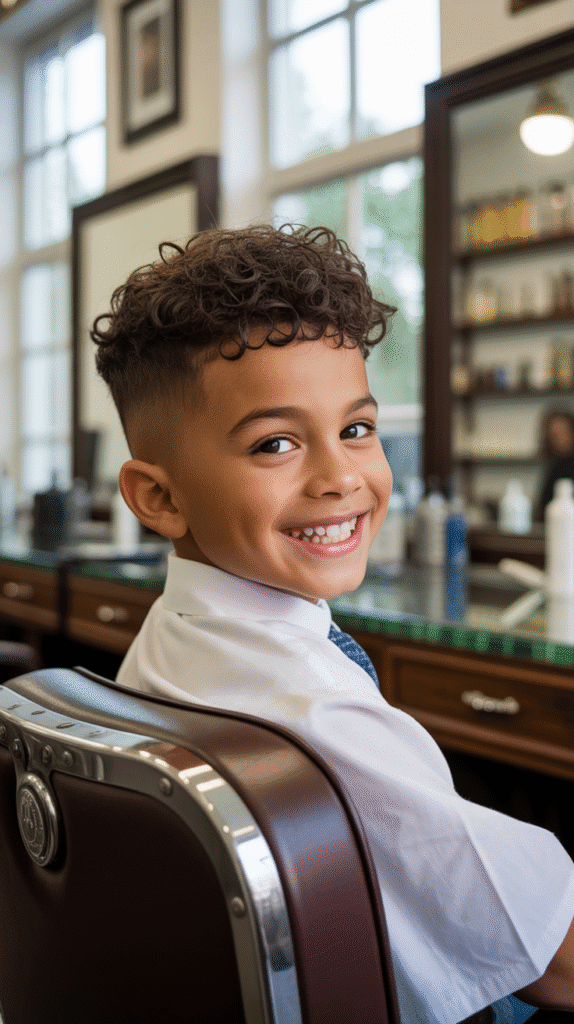
The classic curly fade combines timeless appeal with modern edge, making it one of the most requested styles for boys with curly hair.
This cut keeps length and volume on top while gradually tapering the sides and back, creating a clean silhouette that highlights the natural curl pattern.
- The fade typically starts with a #1 or #2 guard at the bottom and gradually blends upward to meet the longer curls on top.
- This style works exceptionally well for boys with medium to tight curl patterns because the contrast between the short sides and voluminous top creates visual interest.
- Maintenance involves regular trims every 3-4 weeks to keep the fade sharp and neat.
- Parents appreciate this cut because it keeps hair off the ears and neck, making it practical for sports and warm weather.
- The versatility of this style allows for different fade heights (low, mid, or high) depending on your child’s face shape and personal preference.
- Styling requires minimal effort—simply apply a leave-in conditioner or light curl cream to damp hair and let it air dry.
2. Curly Top with Undercut

The curly top with undercut creates dramatic contrast by maintaining substantial length on top while keeping the sides and back extremely short or even shaved.
This bold style is perfect for boys who want to make a statement with their curls.
- The disconnection between the long top and short sides is intentional and sharp, without the gradual blending found in fades.
- This cut requires more frequent maintenance for the shaved portions (every 2-3 weeks) while the top can be trimmed every 6-8 weeks.
- The substantial length on top provides multiple styling options, from pushing curls back to letting them fall forward naturally.
- This style works best for boys with thick, voluminous curls that can support the weight and height this cut creates.
- A strong-hold curl cream or mousse helps define the curls on top while keeping them from becoming unruly throughout the day.
- The undercut provides relief from heat and keeps the style looking intentional rather than overgrown.
3. The Curly Frohawk
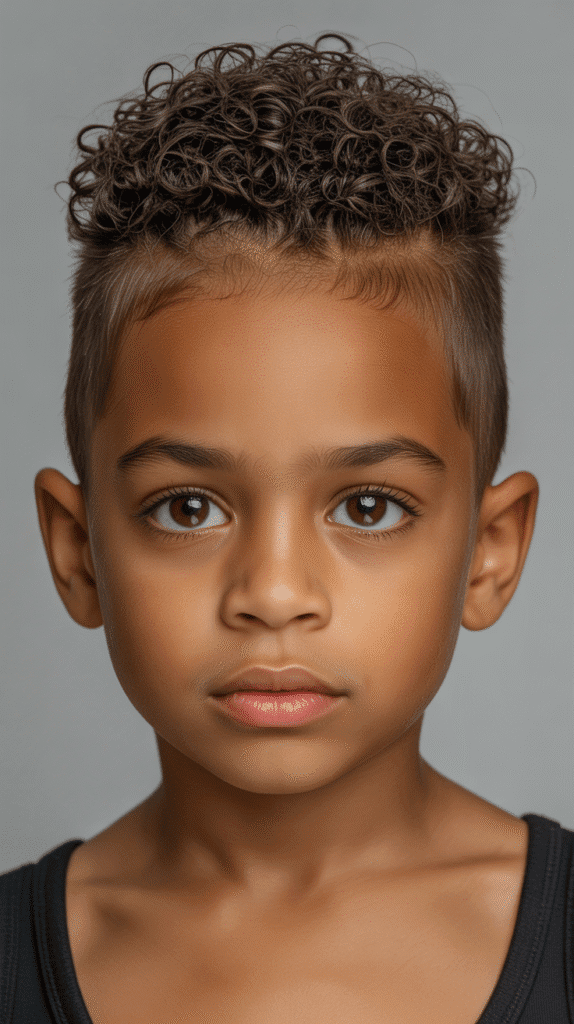
The curly frohawk (or faux hawk) channels edgy style while remaining school-appropriate and parent-approved.
This cut creates a mohawk illusion by keeping the center strip of hair longer while cutting the sides shorter.
- The center section typically measures 2-4 inches in length, depending on the child’s age and curl tightness.
- Sides are usually cut with a low to mid fade, creating the mohawk shape without actually shaving a dramatic line.
- This style celebrates natural texture and is particularly striking on boys with type 3c to 4c curl patterns.
- Styling is straightforward—apply a curl-defining product to the center section and use your fingers to encourage the curls to stand upward.
- The frohawk grows out gracefully, transitioning naturally to other styles without awkward in-between phases.
- This cut works well for active boys because the shorter sides keep them cool while the defined center maintains personality.
4. Long Curly Layers
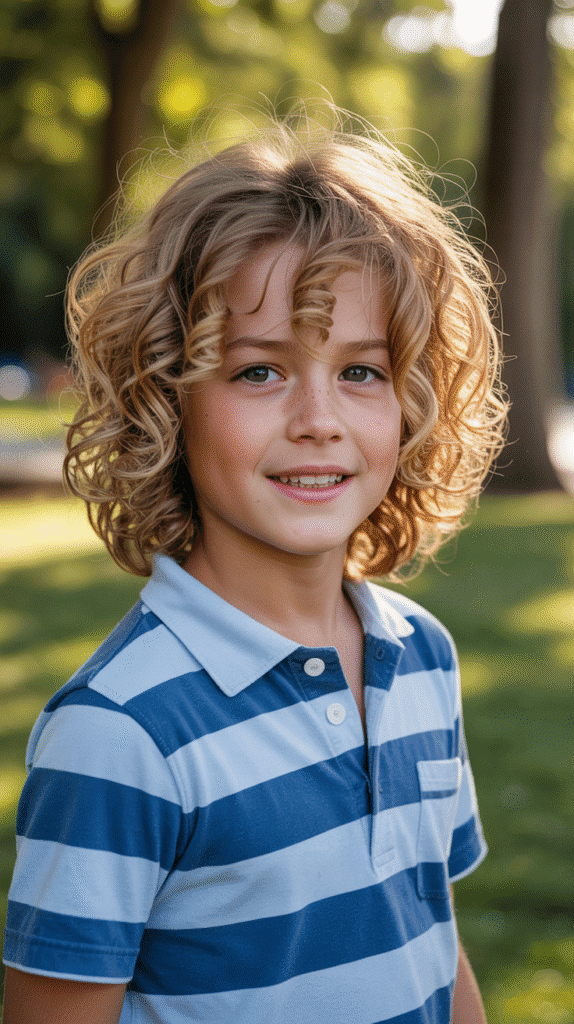
Long curly layers embrace your little boy’s natural length while adding shape and preventing the triangular silhouette that can occur with one-length curly hair.
Strategic layering creates movement and reduces bulk.
- Layers should be cut when the hair is dry to accurately assess how the curls will bounce and settle.
- This style works beautifully for boys with loose to medium curl patterns (2b to 3b) who want to grow their hair out.
- The longest layers typically frame the face while shorter layers on top add volume and prevent flatness at the crown.
- Maintenance involves regular trims every 8-10 weeks to prevent split ends and maintain the layer structure.
- A lightweight leave-in conditioner and curl cream keep layers defined without weighing down the hair.
- This cut requires more styling time than shorter options but offers a unique, flowing appearance that many boys love.
- Parents should ensure their child is willing to participate in the daily detangling and conditioning routine this length requires.
5. The Curly Bowl Cut (Modern Version)

The modern curly bowl cut reimagines this classic style with updated proportions and texture-enhancing techniques.
Unlike the blunt cuts of decades past, today’s version works with the curl pattern to create a soft, rounded shape.
- The cut creates a circular silhouette that follows the natural shape of the head while maintaining even length all around.
- Modern versions incorporate subtle layering to prevent the heavy, blunt appearance of traditional bowl cuts.
- This style is particularly suited for younger boys (ages 2-6) with medium density curls that naturally form ringlets.
- The bowl cut is low-maintenance for daily styling—simply wet, apply product, and allow to air dry.
- Regular trims every 5-6 weeks maintain the rounded shape and prevent the style from looking overgrown.
- This cut keeps hair out of the face while still showcasing beautiful curls, making it practical for preschool and early elementary ages.
6. Textured Curly Crop
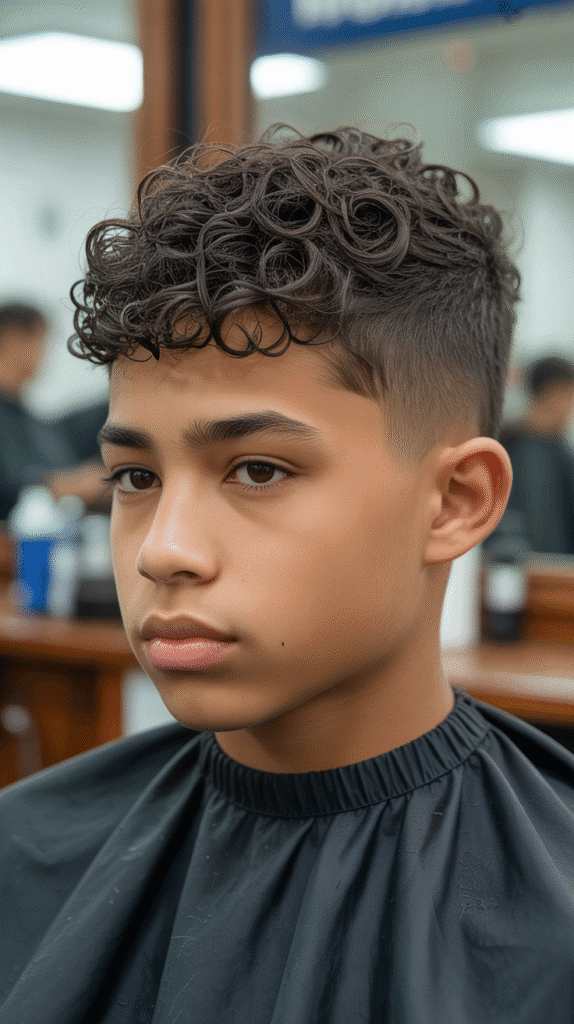
The textured curly crop keeps everything relatively short while maximizing the natural texture and movement of curls.
This contemporary style offers a neat appearance with personality.
- Hair is typically cut to 1-2 inches throughout, allowing curls to form without creating excessive volume.
- The cut uses point-cutting and texturizing techniques to remove bulk while enhancing the curl definition.
- This style is ideal for boys with medium to thick curl density who want a tidy look without sacrificing their natural texture.
- Maintenance is minimal—a dime-sized amount of curl cream worked through damp hair provides all-day definition.
- The crop grows out evenly, making it forgiving for parents who can’t commit to frequent salon visits.
- This cut works across various curl types from wavy to coily, adapting to different textures beautifully.
- The short length makes it perfect for athletes and boys who prefer fuss-free morning routines.
7. Side Part with Curls
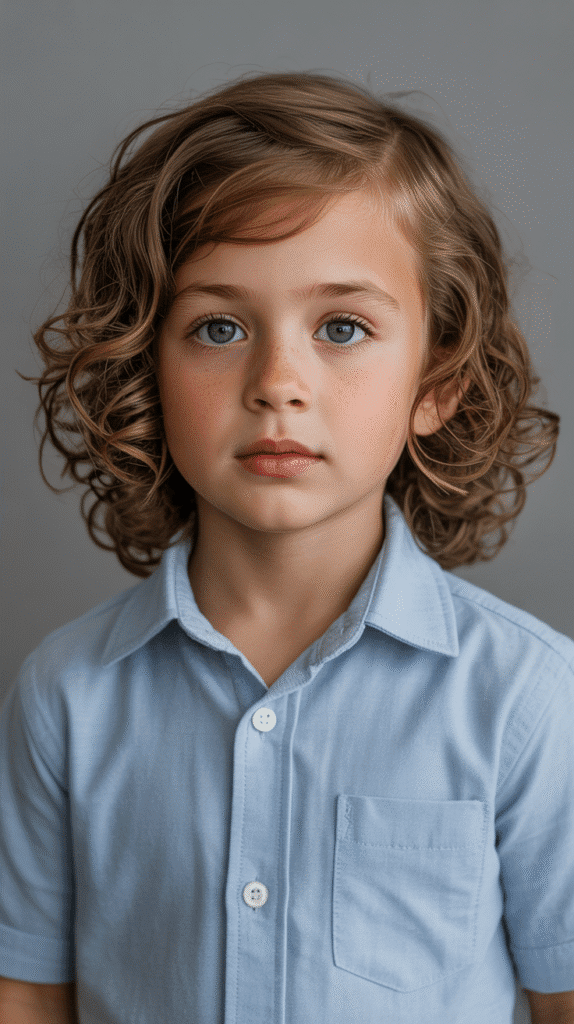
The side part with curls brings a polished, gentlemanly quality to curly hair while maintaining a youthful appearance.
This classic style creates structure through the defined part while letting curls flow naturally.
- The part should be created when hair is wet and reinforced daily to train the hair to fall in that direction.
- This style works best with looser curl patterns (2a to 3a) that have enough weight to stay in place with the part.
- A small amount of light-hold gel or cream helps maintain the part definition throughout the day.
- The sides and back can be kept at medium length or slightly tapered for added neatness.
- This cut is excellent for special occasions, school photos, and boys who prefer a more traditional appearance.
- The side part naturally frames the face and can be adjusted to the left or right based on the child’s natural growth pattern and face shape.
8. Curly Afro
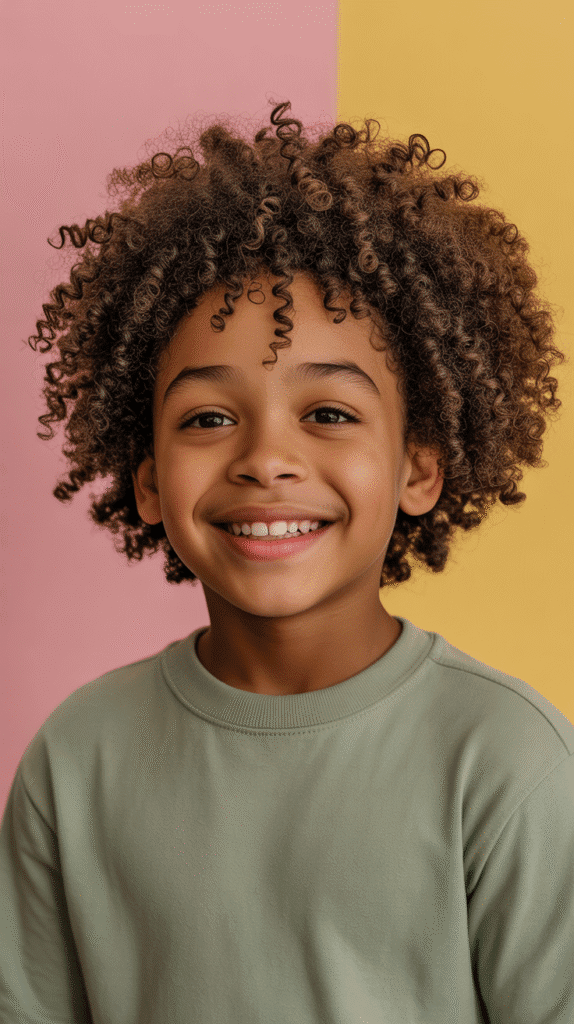
The curly afro celebrates natural hair in its fullest form, creating a symmetrical, rounded shape that radiates confidence and cultural pride.
This iconic style requires patience to grow but makes a powerful statement.
- Achieving a balanced afro shape requires regular shaping every 6-8 weeks to maintain the circular silhouette.
- The style works best with type 3c to 4c curl patterns that naturally grow outward rather than downward.
- Daily moisture is essential—use a water-based spray followed by a natural oil to keep curls hydrated and defined.
- A wide-tooth comb or afro pick should be used gently to shape and lift the hair without disrupting the curl pattern.
- The afro can be worn at various sizes, from a smaller, more controlled version to a large, statement-making style.
- This cut teaches boys to embrace their natural texture and provides an opportunity to discuss cultural heritage and hair pride.
- Nighttime maintenance involves using a satin bonnet or pillowcase to prevent frizz and maintain shape.
9. Curly Quiff
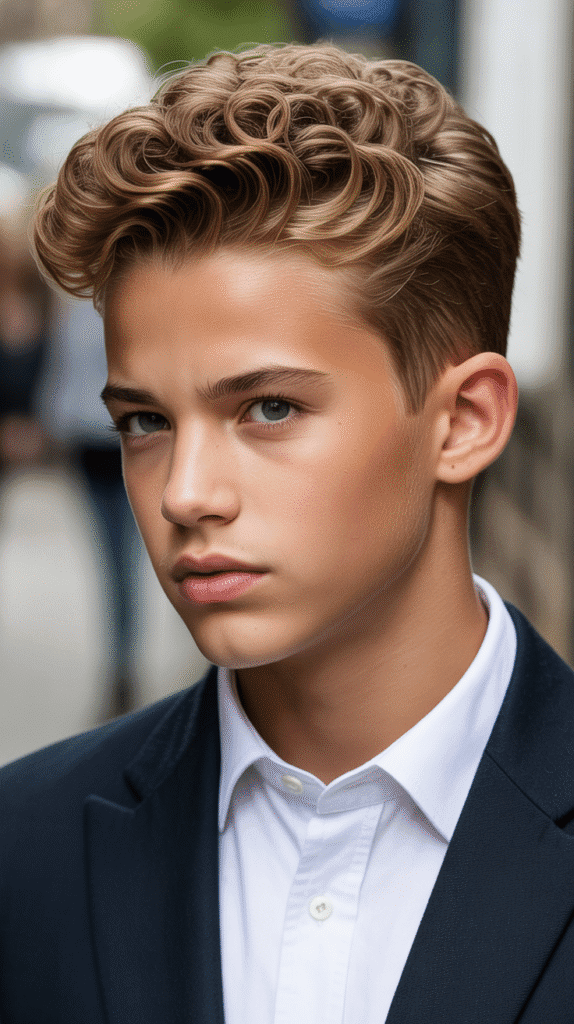
The curly quiff adds height and drama to the front section of hair while keeping the sides and back more controlled.
This style bridges classic and contemporary aesthetics perfectly.
- The quiff is created by leaving 3-4 inches of length in the front section while gradually reducing length toward the crown.
- Sides are typically faded or cut short to emphasize the height and volume of the quiff.
- This style requires daily styling—apply a curl cream to damp hair and use your fingers to push the front section upward and slightly back.
- The curly quiff works across various curl types but is most striking with medium to loose curls that hold the upward shape well.
- A light-hold hairspray can help maintain the quiff throughout a busy day of school and play.
- This cut is ideal for boys who want a style that feels grown-up and intentional while still being age-appropriate.
10. Short All-Over Curls

Short all-over curls provide a uniform, neat appearance that requires minimal daily styling while still showcasing natural texture.
This practical cut is perfect for busy families and active boys.
- Hair is cut to approximately half an inch to one inch throughout, allowing curls to form without creating bulk.
- This cut works wonderfully across all curl types and is especially practical for boys with very tight or coily curls.
- Maintenance involves a simple wash-and-go routine—cleanse, condition, apply a leave-in product, and let air dry.
- The uniform length means fewer trips to the barber, with cuts needed only every 6-8 weeks.
- This style keeps boys cool during sports and summer activities while eliminating tangles and morning hair struggles.
- The short length prevents curls from becoming uneven or lopsided as they grow, maintaining a neat appearance between cuts.
11. Tapered Curly Cut
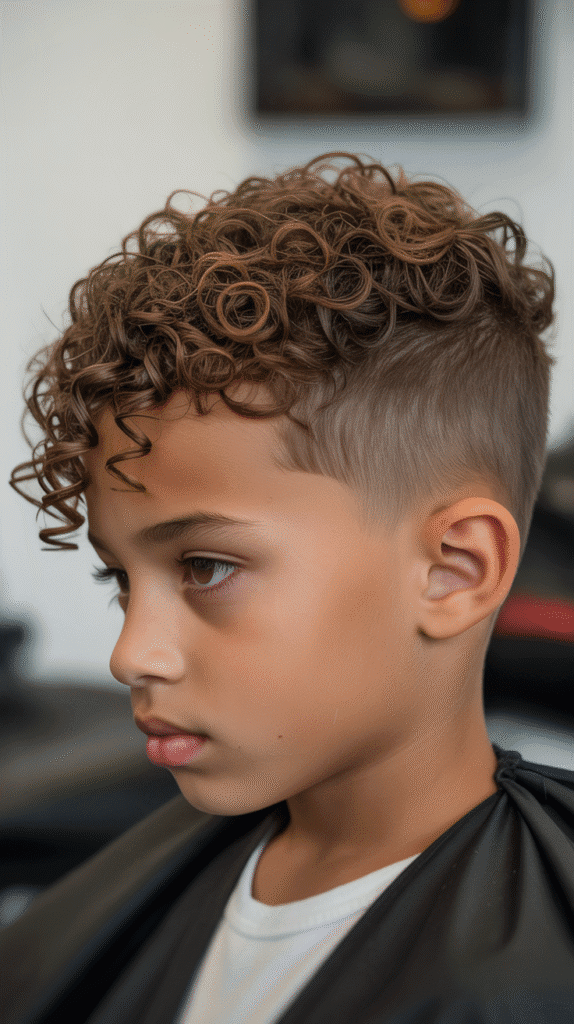
The tapered curly cut gradually reduces hair length from top to bottom, creating a neat, professional appearance that highlights the curls on top.
This versatile style adapts to various curl types and face shapes.
- The taper starts longer at the top (typically 2-3 inches) and gradually shortens toward the neckline and ears without creating the dramatic contrast of a fade.
- This cut creates a triangular or rectangular silhouette depending on how the top is styled—pushed forward, swept back, or left natural.
- The gentler graduation of the taper makes it more forgiving as it grows out compared to sharper fades.
- Boys with medium curl density and looser curl patterns (2c to 3b) find this cut particularly flattering.
- A curl-defining cream applied to the top section provides definition while the tapered sections need minimal product.
- This style balances professionalism with personality, making it suitable for school, sports, and formal occasions.
12. Curly Mohawk with Line Design

The curly mohawk with line design takes the traditional mohawk concept and personalizes it with shaved patterns or lines in the faded sides.
This creative style lets boys express their individuality.
- The center strip of curls typically measures 2-3 inches wide and maintains 2-4 inches of length depending on curl tightness.
- Line designs can be simple (single straight lines) or complex (geometric patterns, waves, or symbols) based on the child’s preference.
- This style requires maintenance every 2-3 weeks as the line designs and fade lose definition as hair grows.
- The combination of natural texture and deliberate design creates a unique look that stands out in photos and social settings.
- Boys should participate in choosing the line design to ensure they feel ownership and pride in their haircut.
- This cut works best with type 3b to 4c curls that provide substantial texture contrast with the shaved designs.
13. Curly Top Knot
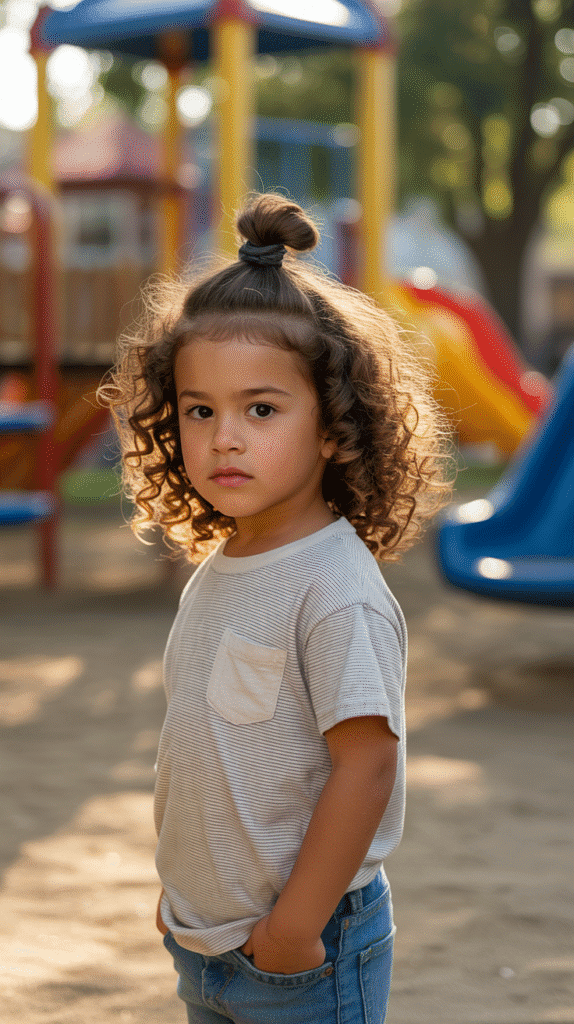
The curly top knot gathers the longer curls on top into a small bun or ponytail while keeping the sides and back short or faded.
This playful style is both practical and stylish.
- Hair on top needs to be at least 4-5 inches long to gather into a functional top knot.
- The sides and back are typically faded or cut short to create contrast and keep the style neat.
- This cut is perfect for boys transitioning to longer hair or those who want the option to wear hair up or down.
- A small, snag-free elastic or hair tie secures the top knot without causing breakage.
- The style keeps hair off the face during activities while showcasing the curly texture when the hair is released.
- This cut requires commitment to growing out the top section, which can take 6-12 months depending on hair growth rate.
14. Asymmetrical Curly Cut

The asymmetrical curly cut creates intentional imbalance by keeping one side longer than the other, offering a fashion-forward look that works surprisingly well with curly textures.
- One side is typically left 2-3 inches longer than the other, with the longer side falling over the eye or ear for dramatic effect.
- This style works best for boys with loose to medium curls (2b to 3b) that have enough weight to hang in the intended direction.
- The asymmetry should be intentional and clearly defined rather than appearing accidental or uneven.
- Styling involves applying product and encouraging the longer side to fall in its intended direction while keeping the shorter side neat.
- This cut makes a bold statement and is ideal for boys who enjoy standing out and expressing creativity through their appearance.
- As the cut grows out, it can be adjusted to return to symmetry or maintained with regular trims to preserve the asymmetrical effect.
15. Curly Pompadour
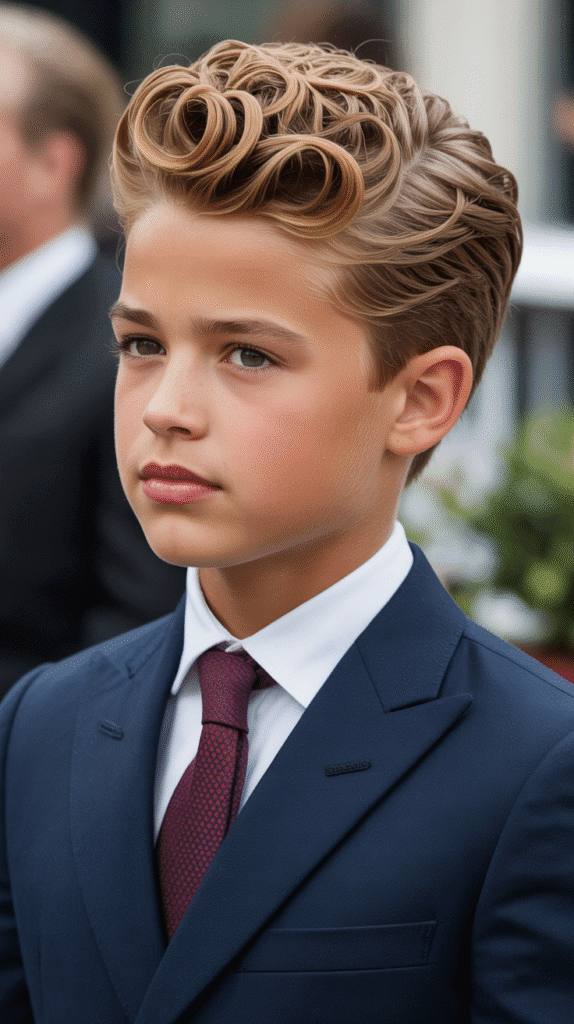
The curly pompadour combines vintage elegance with natural texture, creating substantial height and volume in the front while keeping the sides more controlled.
This sophisticated style adds maturity to a young boy’s appearance.
- The front section requires 3-4 inches of length to achieve the characteristic pompadour height and sweep.
- Sides are cut shorter, typically with a taper or fade, to emphasize the volume on top.
- This style requires daily styling effort—apply a curl cream or mousse to damp hair and use a blow dryer with a diffuser attachment to create lift at the roots.
- A comb or brush can gently guide the front section upward and backward while the blow dryer sets the shape.
- The curly pompadour works best for special occasions, performances, or boys who enjoy putting effort into their appearance.
- This cut teaches boys about grooming and style maintenance while giving them a distinctive, memorable look.
16. Two-Strand Twist Out Cut
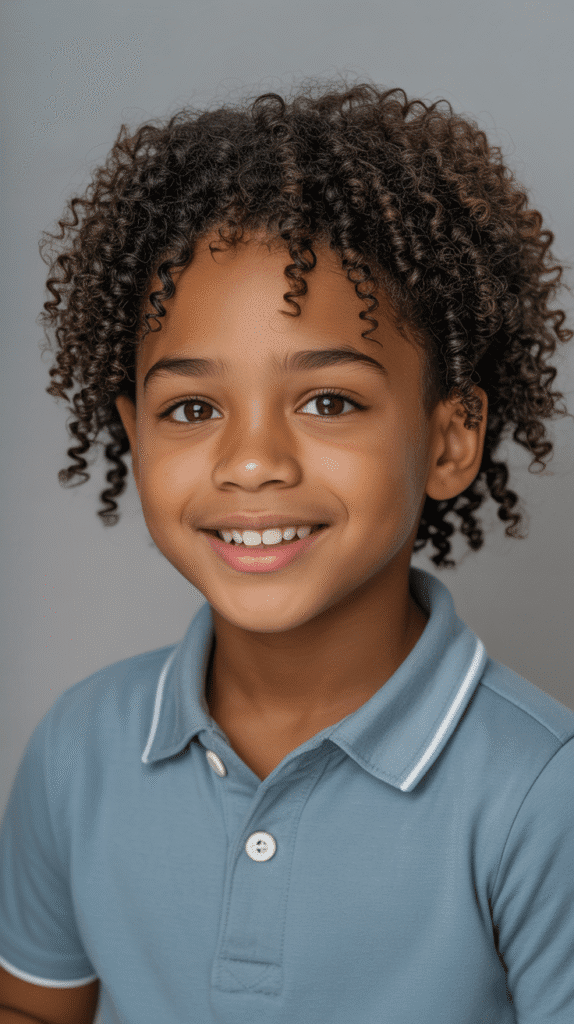
The two-strand twist out cut is specifically designed to showcase the texture created by this popular natural hair styling technique.
The cut maintains appropriate length and shaping for optimal twist out results.
- Hair is typically kept at 2-4 inches throughout to create balanced volume and definition when twisted out.
- The cut includes subtle layering to prevent a boxy shape and encourage natural movement.
- This style is specifically suited for type 3c to 4c hair textures that benefit from twist-and-release styling methods.
- Creating the twist out involves sectioning damp hair, applying a curl cream or butter, twisting small sections, and allowing them to dry before unraveling.
- The resulting texture lasts 3-7 days with proper nighttime maintenance (retwisting or protecting with a satin bonnet).
- This cut and styling method promotes hair health by minimizing manipulation and maintaining moisture.
17. Curly Caesar Cut

The curly Caesar cut brings structure to curly hair by maintaining short, even length on top with a horizontal fringe line at the forehead.
This Roman-inspired style is both classic and practical.
- The defining feature is the straight, horizontal fringe that creates a clear line across the forehead regardless of the curl pattern underneath.
- Hair is typically kept to 1-2 inches throughout with minimal variation in length.
- This cut works across various curl types and is particularly striking on boys with tighter curl patterns that create interesting texture contrast with the defined fringe.
- The Caesar cut requires minimal daily styling—a small amount of product provides definition and light hold.
- Regular trims every 4-5 weeks maintain the characteristic horizontal fringe and overall shape.
- This style offers a neat, intentional appearance that works well for school and structured activities while still celebrating natural texture.
18. High Top Curls
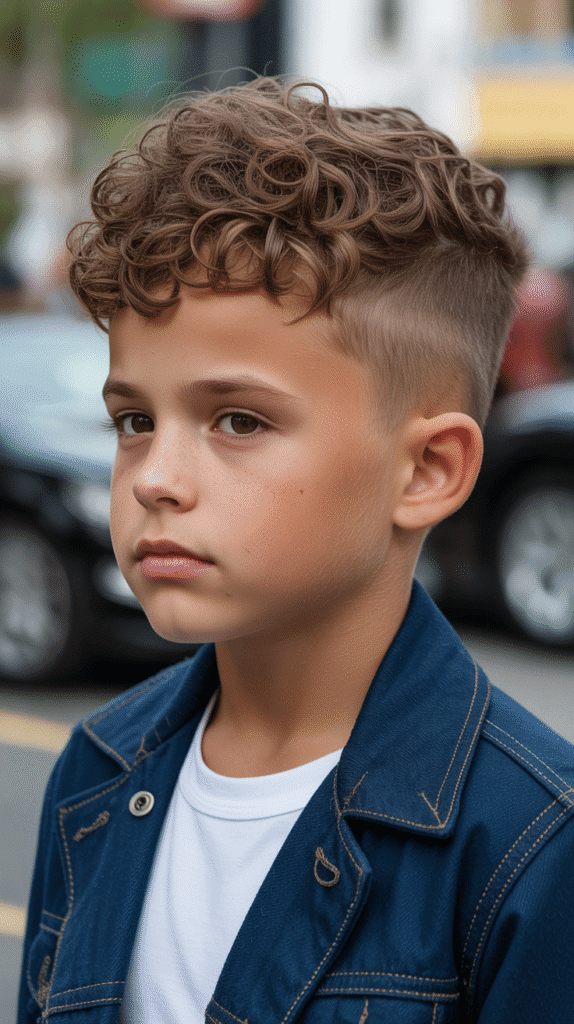
The high top curls create dramatic vertical height on top while keeping the sides very short or faded, resulting in a striking silhouette that celebrates natural hair texture and cultural style heritage.
- The top section is grown to 3-6 inches and shaped to create a flat-top or rounded geometric form rising prominently from the head.
- Sides and back are cut very short, typically with clippers, creating maximum contrast with the voluminous top.
- This iconic style works best with type 3c to 4c curl patterns that naturally grow upward and outward.
- Maintaining the shape requires regular picking or combing upward to train the curls to grow in the desired direction.
- Trims every 4-6 weeks keep the sides tight and the top shaped properly.
- The high top is a statement style that requires confidence and commitment but delivers undeniable visual impact.
19. Curly Burst Fade
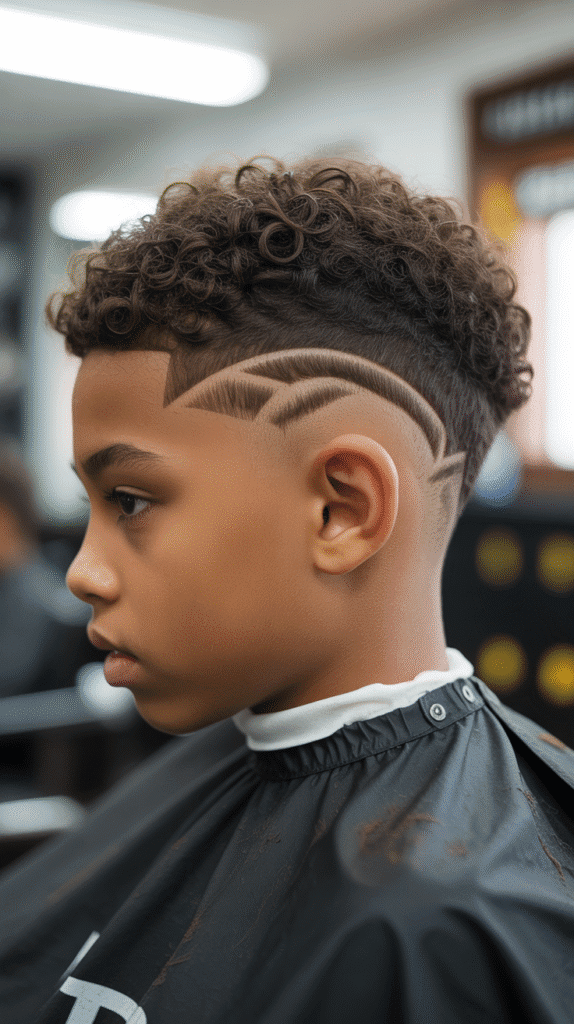
The curly burst fade creates a semi-circular fade pattern that radiates around the ear, maintaining length on top while creating an artistic fade design on the sides.
This contemporary style blends technical barbering with natural texture.
- The fade creates a sunburst or curved pattern that follows the natural contour around the ear rather than a straight vertical fade.
- This style maintains more length behind the ear and at the neckline compared to traditional fades.
- The burst fade works particularly well with curly mohawks or styles where the top is worn forward.
- The unique fade pattern requires a skilled barber familiar with this specific technique.
- Maintenance involves touch-ups every 2-3 weeks to keep the curved fade pattern crisp and visible.
- This cut adds artistic flair to curly hair while maintaining practicality and ease of styling.
20. Shaggy Curly Layers
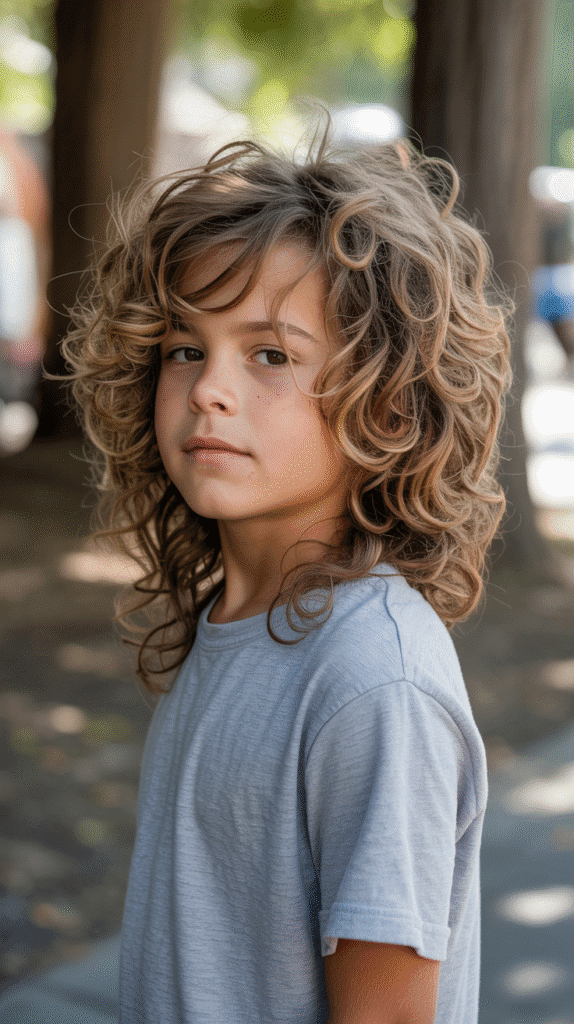
Shaggy curly layers embrace a more relaxed, tousled aesthetic with deliberately uneven lengths creating movement and carefree texture.
This style rejects rigid structure in favor of natural flow.
- Layers are cut at varying lengths throughout with no specific pattern, creating an intentionally undone appearance.
- This style works beautifully with loose to medium curl patterns (2a to 3b) that have natural movement.
- The shaggy look requires less precision cutting, making it more forgiving between salon visits.
- Styling is minimal—apply a light texturizing product and scrunch or shake hair for a lived-in look.
- This cut suits artistic, creative personalities and boys who prefer a relaxed, low-maintenance style.
- The layers prevent hair from looking too heavy or triangular as it grows out.
- Parents appreciate that the intentionally messy nature means the cut always looks “right” even when growing out.
21. Defined Ringlet Cut
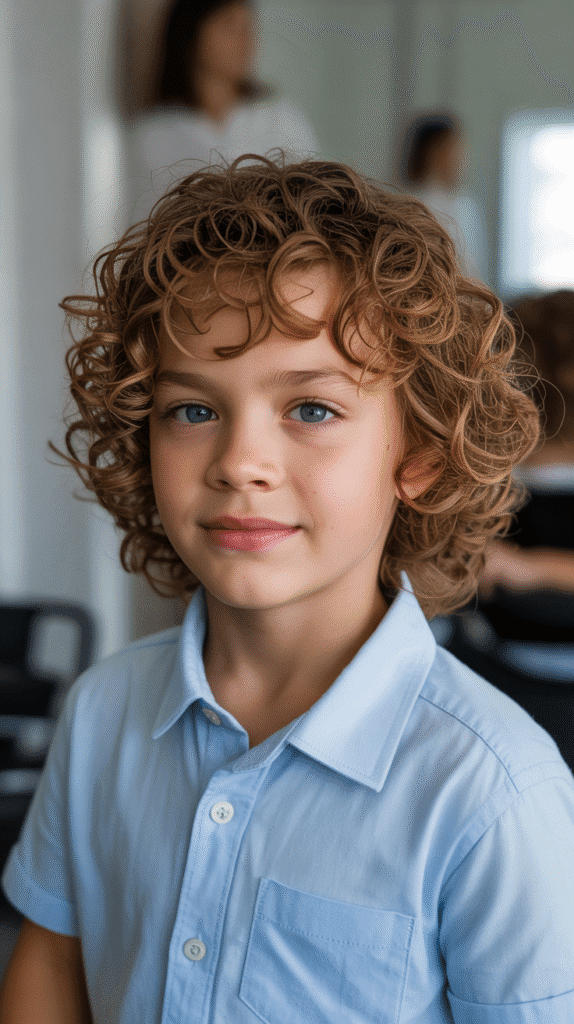
The defined ringlet cut is specifically designed to enhance and showcase tight, spiral curls by cutting at optimal lengths that maximize curl definition and spring.
This cut celebrates the most distinctive characteristic of curly hair.
- Hair is cut when dry and curls are in their natural state to ensure each ringlet is cut at the ideal point in its spiral pattern.
- Length typically ranges from 2-4 inches to allow ringlets to form completely without excessive weight pulling them down.
- This cutting technique involves snipping individual curl spirals rather than cutting straight across sections.
- The style works specifically for type 3a to 3c curl patterns that form distinct, separate ringlets.
- A curl-defining cream or gel applied to soaking wet hair and scrunched upward produces the best ringlet definition.
- Diffusing on low heat or air drying preserves the ringlet formation without creating frizz.
- This cut requires a stylist experienced with curly hair who understands how to work with individual curl patterns.
22. Temp Fade with Curly Top
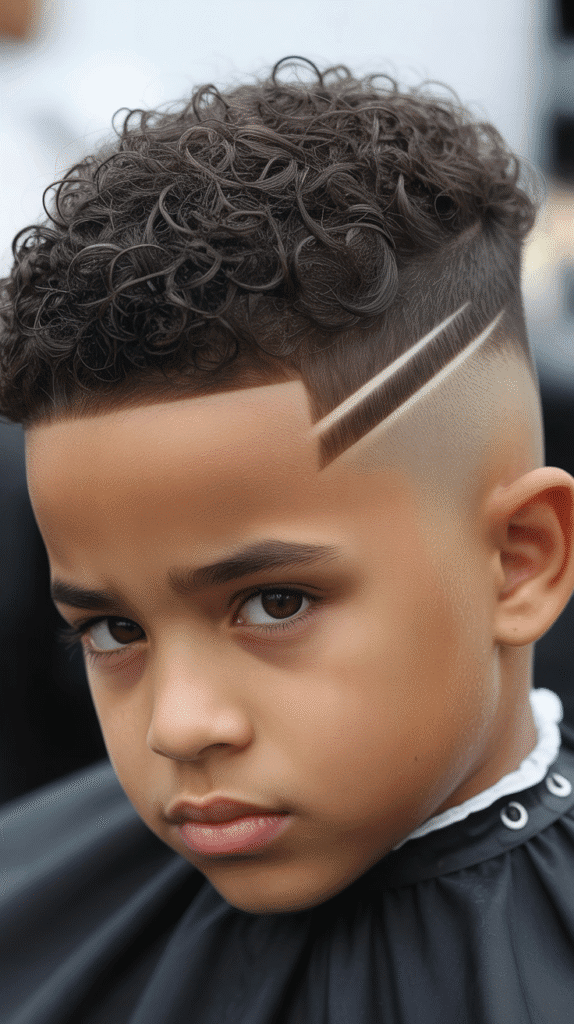
The temp fade (or temple fade) specifically targets the hairline around the temples and sides of the forehead, creating a clean frame for the face while maintaining fuller curls on top.
- The fade begins at the temples and curves around the front hairline, typically extending an inch or two above the ears.
- This style maintains more length throughout the rest of the sides and back compared to full fades.
- The temp fade creates a cleaner, more defined face frame, making it popular for boys who want a neat appearance without drastically cutting overall length.
- This cut works across all curl types and is particularly effective for boys with lower hairlines or those wanting to emphasize facial features.
- Maintenance requires touch-ups every 3-4 weeks to keep the temple area sharp and defined.
- The style balances professional neatness with maintaining substantial curly texture throughout most of the head.
23. Loose Wave Cut
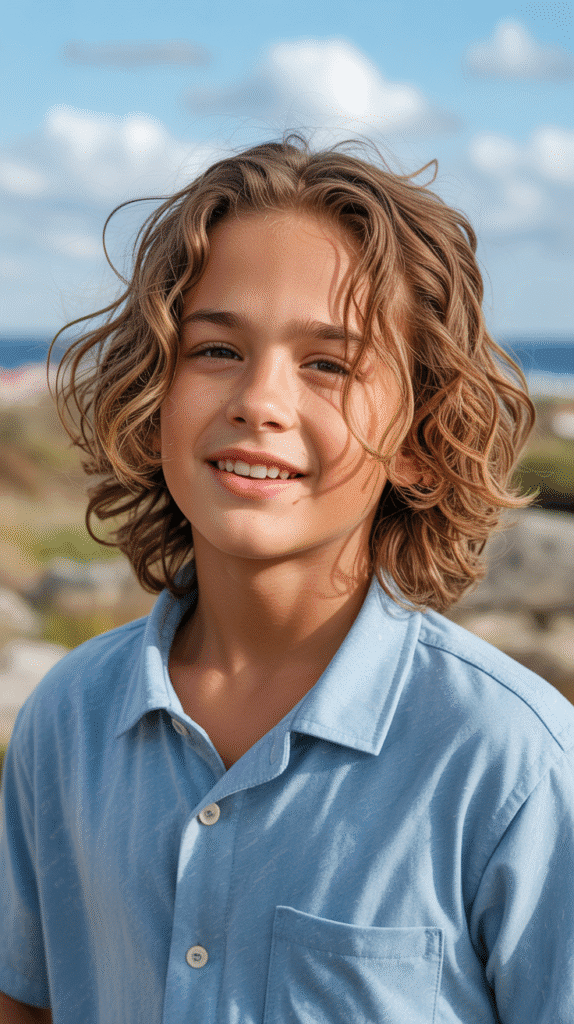
The loose wave cut is designed for boys with wavy rather than tightly curled hair, using specific cutting techniques to enhance the natural wave pattern and prevent hair from lying flat or becoming shapeless.
- Layers are cut to varying lengths to encourage waves to form at different points, creating dimension and preventing flatness.
- This cut typically maintains 2-4 inches of length throughout, which is optimal for loose wave formation.
- Boys with type 2a to 2c hair patterns benefit most from this cutting approach.
- A sea salt spray or light texturizing product enhances the natural wave pattern without adding stiffness.
- The style can be worn with a middle part, side part, or pushed back depending on preference.
- This cut requires less moisture-intensive products than tighter curls, making it lower maintenance while still providing texture.
24. Graduated Curly Bob
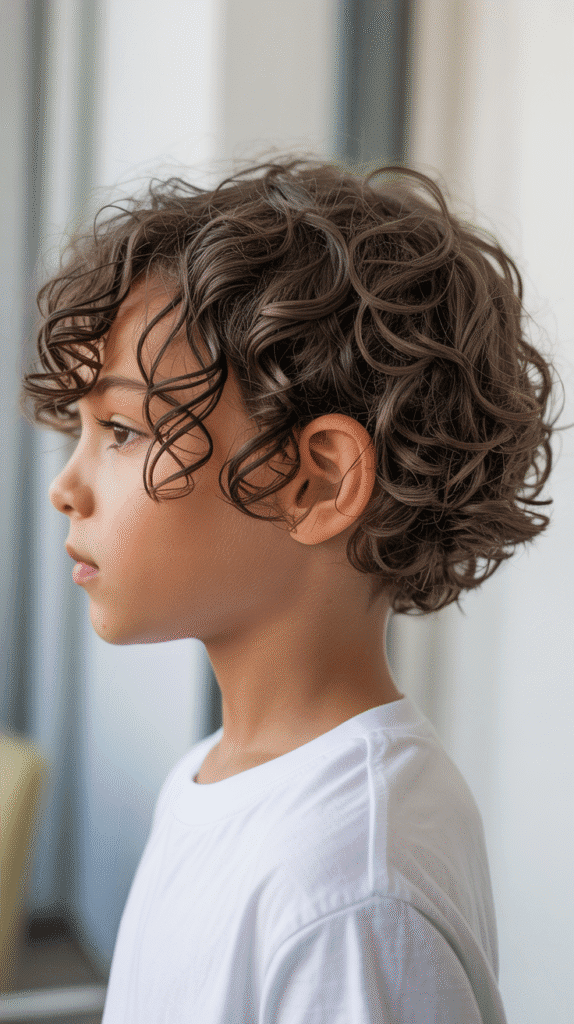
The graduated curly bob creates a sophisticated A-line shape where the back is cut shorter than the front, providing structure to curly hair while maintaining a youthful appearance.
This style offers a unique alternative to typical boy cuts.
- The front sections near the face are left longest (typically 3-4 inches) while the back is cut progressively shorter (1-2 inches).
- This angular shape creates automatic movement and prevents the boxy appearance that can occur with one-length curly cuts.
- The graduated bob works well with medium density curls and looser curl patterns (2c to 3b).
- Styling involves applying product and encouraging the front sections to frame the face while keeping the back tidy.
- This cut challenges traditional gender norms in children’s hairstyles and suits boys with artistic, creative personalities and open-minded families.
- The graduation provides built-in shape that looks intentional rather than simply overgrown.
25. Tapered Afro with Part
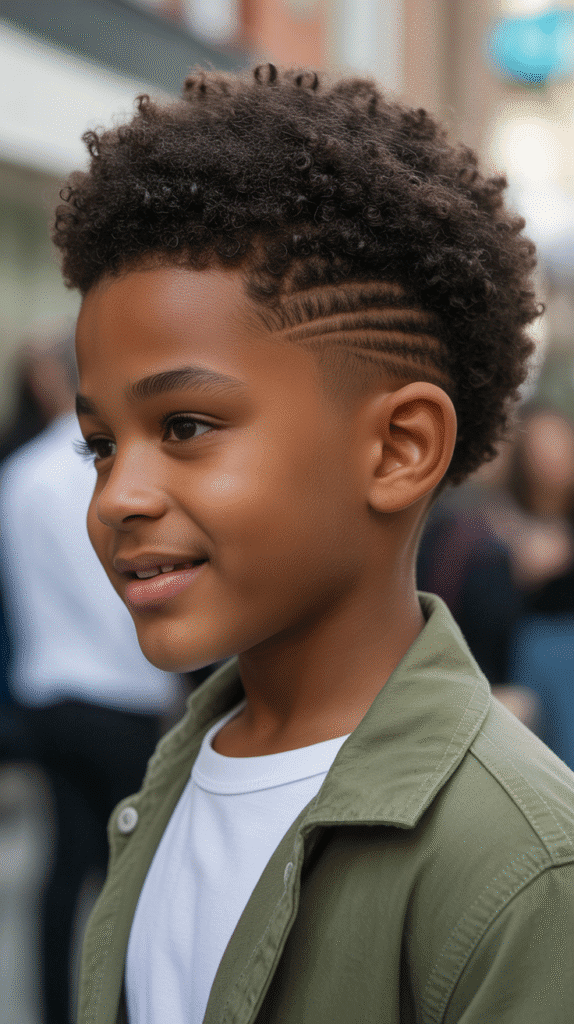
The tapered afro with part combines the cultural significance and natural celebration of the afro shape with the structural element of a defined side part, creating a style that bridges traditional and contemporary aesthetics.
- The overall shape maintains the rounded afro silhouette while incorporating a distinct part line on one side.
- Hair is gradually tapered at the neckline and around the ears to create a cleaner finish compared to a full afro.
- The part should be created when hair is damp and reinforced regularly to remain visible through the curly texture.
- This style works with type 3c to 4c curl patterns and celebrates natural hair while adding structured styling.
- A curl sponge can be used to enhance texture definition throughout the afro while maintaining the part.
- The combination of natural shape and defined structure makes this cut appropriate for various settings from casual to formal.
- This style teaches boys that natural hair can be styled with intention and versatility.
Essential Curl Care Tips
Understanding Your Child’s Curl Pattern
- Identifying the specific curl type helps in choosing the most suitable haircut from the 25 options presented.
- Curl patterns can vary throughout the head, with tighter curls often at the nape and looser curls at the crown.
- Hair texture may change as children grow, requiring adjustments to cutting and styling approaches.
- Consulting resources from the Naturally Curly community provides additional guidance on curl typing and care.
Communication with Your Barber or Stylist
- Bring reference photos of the specific style you want, ideally showing boys with similar curl patterns to your child.
- Explain your child’s daily routine and activity level to help the stylist recommend the most practical cut.
- Ask whether the stylist has specific training or experience with curly hair cutting techniques.
- Request that the cut be performed on dry hair when possible, as curly hair behaves differently when wet and cutting dry provides more accurate results.
- Discuss maintenance requirements and schedule follow-up appointments before leaving the salon.
Daily Maintenance and Styling Products
- Curly hair requires more moisture than straight hair—invest in quality leave-in conditioners and curl creams.
- Avoid products containing sulfates, silicones, and drying alcohols, which strip natural oils and create buildup.
- The “scrunch” method (gently squeezing curls upward in your palm) encourages curl formation and reduces frizz.
- A microfiber towel or soft t-shirt absorbs water without roughing up the hair cuticle like traditional terry cloth towels.
- Detangle with fingers or a wide-tooth comb while hair is wet and coated with conditioner, never when dry.
- Refresh curls between wash days by lightly misting with water and applying a small amount of product.
Nighttime Protection
- A satin or silk pillowcase reduces friction that causes frizz and breakage during sleep.
- For longer styles, consider a satin bonnet or loosely pineappling hair (gathering curls at the top of the head with a scrunchie).
- Children with shorter cuts may need minimal nighttime protection but can benefit from a light mist and scrunch in the morning.
Washing Frequency
- Curly hair typically requires washing only 1-2 times per week to maintain natural oils.
- Co-washing (using conditioner instead of shampoo) between regular washes provides cleansing without stripping moisture.
- A clarifying shampoo used monthly removes product buildup without the harshness needed for weekly washing.
- Water temperature matters—lukewarm water is ideal, while hot water can dry out curls and cold water seals the cuticle for shine.
Conclusion
Choosing from these 25 little boy curly haircuts gives your child the opportunity to celebrate his natural texture while finding a style that matches his personality, activity level, and your family’s maintenance preferences.
From the clean lines of a curly fade to the bold statement of a high top, from the practical simplicity of short all-over curls to the sophisticated elegance of a curly pompadour, each style in this collection honors the unique characteristics of curly hair.
The key to success lies in matching the cut to your son’s specific curl pattern, consulting with an experienced stylist who understands curly hair techniques, and establishing a maintenance routine that keeps curls healthy, defined, and manageable.
Remember that the best haircut is one your child feels confident wearing—involve him in the decision-making process, show him photos of the options, and consider starting with a less dramatic change if he’s hesitant about trying something new.
With the right cut and proper care, these little boy curly haircuts can transform daily hair struggles into a source of pride and self-expression.
Whether your goal is low-maintenance practicality, standout style, or cultural celebration, this comprehensive guide to 25 little boy curly haircuts that show off those curls provides the inspiration and information needed to make your next barbershop visit a success.
